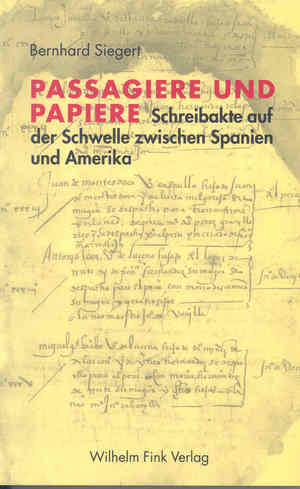Cornelia Vismann: Files: Law and Media Technology (2000/2008)
Filed under book | Tags: · bureaucracy, computing, document, governmentality, law, media archeology, media theory, technology, writing

“Quod non est in actis, non est in mundo. (What is not on file is not in the world.) Once files are reduced to the status of stylized icons on computer screens, the reign of paper files appears to be over. With the epoch of files coming to an end, we are free to examine its fundamental influence on Western institutions. From a media-theoretical point of view, subject, state, and law reveal themselves to be effects of specific record-keeping and filing practices. Files are not simply administrative tools; they mediate and process legal systems. The genealogy of the law described in Vismann’s Files ranges from the work of the Roman magistrates to the concern over one’s own file, as expressed in the context of the files kept by the East German State Security. The book concludes with a look at the computer architecture in which all the stacks, files, and registers that had already created order in medieval and early modern administrations make their reappearance.”
Originally published in German as Akten. Medientechnik und Recht, Fischer, Frankfurt am Main, 2000
Translated by Geoffrey Winthrop-Young
Publisher Stanford University Press, 2008
Meridian: Crossing Aesthetics series
ISBN 080475151X, 9780804751513
187 pages
Review (Liam Cole Young, Theory, Culture & Society)
PDF (7 MB, updated on 2016-12-23)
Comment (0)Andrew Blum: Tubes: A Journey to the Center of the Internet (2012)
Filed under book | Tags: · internet, media archeology, media infrastructure, network archeology, networks

When your Internet cable leaves your living room, where does it go? Almost everything about our day-to-day lives—and the broader scheme of human culture—can be found on the Internet. But what is it physically? And where is it really? Our mental map of the network is as blank as the map of the ocean that Columbus carried on his first Atlantic voyage. The Internet, its material nuts and bolts, is an unexplored territory. Until now.
In Tubes, journalist Andrew Blum goes inside the Internet’s physical infrastructure and flips on the lights, revealing an utterly fresh look at the online world we think we know. It is a shockingly tactile realm of unmarked compounds, populated by a special caste of engineer who pieces together our networks by hand; where glass fibers pulse with light and creaky telegraph buildings, tortuously rewired, become communication hubs once again. From the room in Los Angeles where the Internet first flickered to life to the caverns beneath Manhattan where new fiber-optic cable is buried; from the coast of Portugal, where a ten-thousand-mile undersea cable just two thumbs wide connects Europe and Africa, to the wilds of the Pacific Northwest, where Google, Microsoft, and Facebook have built monumental data centers—Blum chronicles the dramatic story of the Internet’s development, explains how it all works, and takes the first-ever in-depth look inside its hidden monuments.
This is a book about real places on the map: their sounds and smells, their storied pasts, their physical details, and the people who live there. For all the talk of the “placelessness” of our digital age, the Internet is as fixed in real, physical spaces as the railroad or telephone. You can map it and touch it, and you can visit it. Is the Internet in fact “a series of tubes” as Ted Stevens, the late senator from Alaska, once famously described it? How can we know the Internet’s possibilities if we don’t know its parts?
Like Tracy Kidder’s classic The Soul of a New Machine or Tom Vanderbilt’s recent bestseller Traffic, Tubes combines on-the-ground reporting and lucid explanation into an engaging, mind-bending narrative to help us understand the physical world that underlies our digital lives.
Publisher Ecco, an imprint of HarperCollins, 2012
ISBN 1443414395, 9781443414395
304 pages
review (Dwight Garner, The New York Times)
review (Iain Morris, The Guardian)
Infrastructural Tourism (commentary, Shannon Mattern, Words in Space blog)
Download (removed on 2013-1-15 upon request of the author)
Comment (0)Bernhard Siegert: Passagiere und Papiere: Schreibakte Auf der Schwelle Zwischen Spanien und Amerika (2006) [German]
Filed under book | Tags: · identity, media archeology, media theory, migration, writing

Passagiere und Papiere ist ein Buch über eine vergessene Urszene der Moderne. In den bürokratischen Ritualen der Narrativierung und Verschriftlichung, durch die all jene infamen Menschen in den Status von legalen Personen initiiert wurden, die an Bord eines Schiffes nach Amerika gehen wollten, wird nicht nur das moderne Untertanensubjekt erfunden, sondern wird auch die Maske zum Träger der Person und Wirklichkeit unlösbar gebunden an ihre papierene Repräsentation. Der Krieg der spanischen Krone gegen die eigene Bevölkerung im 16. Jahrhundert, gegen konvertierte Juden und Mauren, aber auch gegen Arme und Vagabunden, produziert an der Schwelle zur Neuen Welt eine immense kleine Literatur: Ausreiseanträge, Verhörsprotokolle, Zeugenaussagen, Passagierlisten. Von 1535 an durfte niemand mehr in Sevilla ein Schiff besteigen, der nicht vorher in schriftlicher Form vor einem Richter schriftliche Zeugnisse von seiner Identität, seiner Herkunft, seinem anständigen Leben, seinen Narben und Malen erbracht hatte. Das Indienhaus, die “Casa de la Contratación”, wurde so zu einem der ersten Orte in Europa, wo das Beschrieben- und Ezähltwerden aufhörte, ein Privileg der Mächtigen zu sein, und anfing, ein Mittel der Überwachung und der Kontrolle zu werden. Bernhard Siegert rekonstruiert anhand bisher kaum erforschter Quellen aus dem Archivo General de Indias in Sevilla die Rituale und Prozeduren der Legitimation, der Narrativierung, der Registrierung und der Fiktionalisierung, die all jene durchlaufen mußten, die im 16. Jahrhundert an Bord eines der Schiffe nach Amerika gehen wollten. Auf der anderen Seite des Ozeans schließlich verzahnen sich die Passagierlisten mit Einwohnerverzeichnissen und Siedlungstopographien. Das Seßhaftmachen der Passagiere bringt rasterförmige Register und registerförmige Raster ins Spiel, die das “Am-Platz-Sein” von Menschen an ein “Am-Platz-Sein” von Lettern binden.
Publisher Wilhelm Fink Verlag, Munich, 2006
ISBN 377054224X, 9783770542246
176 pages
PDF
View online (added on 2014-6-2)

